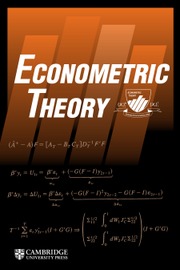Crossref Citations
This article has been cited by the following publications. This list is generated based on data provided by Crossref.
Henry, Jérôme
and
McAdam, Peter
2001.
Vol. 2,
Issue. ,
p.
21.
Altissimo, Filippo
and
Corradi, Valentina
2002.
Bounds for inference with nuisance parameters present only under the alternative.
The Econometrics Journal,
Vol. 5,
Issue. 2,
p.
494.
Altissimo, Filippo
and
Corradi, Valentina
2003.
Strong rules for detecting the number of breaks in a time series.
Journal of Econometrics,
Vol. 117,
Issue. 2,
p.
207.
Corradi, Valentina
and
Swanson, Norman R.
2004.
Bootstrap Procedures for Recursive Estimation Schemes with Applications to Forecast Model Selection.
SSRN Electronic Journal,
Corradi, Valentina
and
Swanson, Norman R.
2005.
Nonparametric Bootstrap Procedures for Predictive Inference Based on Recursive Estimation Schemes.
SSRN Electronic Journal,
Leeb, Hannes
and
Pötscher, Benedikt M.
2005.
MODEL SELECTION AND INFERENCE: FACTS AND FICTION.
Econometric Theory,
Vol. 21,
Issue. 1,
p.
21.
Corradi, Valentina
and
Swanson, Norman R.
2006.
Predictive density and conditional confidence interval accuracy tests.
Journal of Econometrics,
Vol. 135,
Issue. 1-2,
p.
187.
Corradi, Valentina
and
Swanson, Norman R.
2007.
NONPARAMETRIC BOOTSTRAP PROCEDURES FOR PREDICTIVE INFERENCE BASED ON RECURSIVE ESTIMATION SCHEMES*.
International Economic Review,
Vol. 48,
Issue. 1,
p.
67.
Hafner, Christian M.
and
Preminger, Arie
2010.
Deciding between GARCH and stochastic volatility via strong decision rules.
Journal of Statistical Planning and Inference,
Vol. 140,
Issue. 3,
p.
791.
Bandi, Federico M.
Corradi, Valentina
and
Wilhelm, Daniel
2011.
Data-Driven Bandwidth Selection for Nonparametric Nonstationary Regressions.
SSRN Electronic Journal,
Gómez, Víctor
2013.
A Strongly Consistent Criterion to Decide Between I(1) and I(0) Processes Based on Different Convergence Rates.
Communications in Statistics - Simulation and Computation,
p.
130102064343006.
Castagnetti, Carolina
Rossi, Eduardo
and
Trapani, Lorenzo
2015.
Inference on factor structures in heterogeneous panels.
Journal of Econometrics,
Vol. 184,
Issue. 1,
p.
145.
Kao, Chihwa
Trapani, Lorenzo
and
Urga, Giovanni
2018.
Testing for instability in covariance structures.
Bernoulli,
Vol. 24,
Issue. 1,
Oka, Tatsushi
and
Perron, Pierre
2018.
Testing for common breaks in a multiple equations system.
Journal of Econometrics,
Vol. 204,
Issue. 1,
p.
66.
Trapani, Lorenzo
2021.
Testing for strict stationarity in a random coefficient autoregressive model.
Econometric Reviews,
Vol. 40,
Issue. 3,
p.
220.
Corradi, Valentina
Fosten, Jack
and
Gutknecht, Daniel
2023.
Predictive Ability Tests with Possibly Overlapping Models.
SSRN Electronic Journal,
Corradi, Valentina
Fosten, Jack
and
Gutknecht, Daniel
2024.
Predictive ability tests with possibly overlapping models.
Journal of Econometrics,
Vol. 241,
Issue. 1,
p.
105716.

